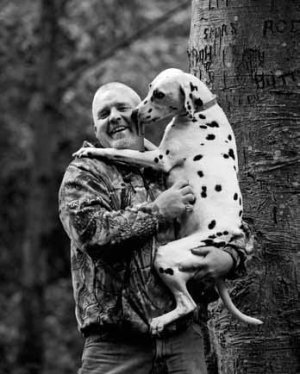articles/Portraiture/petslocation-page3
Shooting Pets on Location - part 3 of 1 2 3
by Paul Walker Published 01/06/2009

Given the size of the daschshunds Paul decided to take them a short distance down his own street and, with the aid of a neighbour's wall and some grass that the council hadn't trimmed as a prop, a variety of shots were taken. 'The key in that situation was definitely to direct and to shoot a variety of images.' Although some 'non-directed' photography plays a part of every photo session with Paul, the vast majority of the allocated time is spent with a clear vision in mind of the photograph worth taking. Where pets demonstrate a good level of loyalty and obedience in respect of the handler's commands, there will inevitably be more opportunities to direct images and capture your intended images within any environment. Pets that have more of a free-spirited nature, combined with selective hearing, have to be persuaded and cajoled far more into the desired position than an obedient pet, whether they be on the move or stationary. The high ISO performance of many recent DSLRs has certainly increased the odds of capturing a sharp, saleable image in certain lowlight environments, such as say woodland, especially if the pet is in motion.
The element of unpredictability that certain pets bring with them (and we are not talking photographing tortoises) can certainly heighten the senses and wits. 'You definitely need to be quick with the camera and have at least a technique that works for you to produce consistently sharp images where intended,' comments Paul. For example, cats are notorious for disappearing if the mood doesn't suit and your time in their presence may well be limited, so having a few different strategies in place can favour the odds in the photographer's direction! Paul photographed one kitten last year that was particularly skittish and admits that it was a difficult shoot. 'It was not quite a scene from Laurel and Hardy but involved plenty of crawling around the owner's sofa!' A year later and Paul was back at the house photographing a new cat addition to the family. The owner told Paul that the now grown-up kitten frequently hides when the doorbell rings and after six months she has yet to find the hiding place of this cat.

Rescue Pets
Aside from the infamous ferrets, which will test your photography skills to the limit, Paul also regards the area of rescue pets, predominantly cats and dogs, as some of the more difficult to photograph. 'The background of many of these pets would make your heart weep and it's important the photography is both sensitive and proportionate to any animal's tolerance limits.' Paul believes that you need to gain a good understanding, from the handler, of the history of a pet before you even pick up the camera and ensure that you stay safe yourself. Paul often photographs for the Dog's Trust for both advertising and fund-raising campaigns and, despite his experience in this field, he ensures that a thorough understanding is gained of the dogs in question before every photography assignment. Some dogs may be particularly boisterous or unsociable around children or other dogs and in such cases the environments have to be carefully selected in advance. Photography can certainly make a difference to the fund-raising capabilities of such organisations, especially when the image portrays a meaningful message. After more than a decade of photographing pets Paul says, 'I never ceased to be amazed by the antics of some of the pets I have worked with. One thing is for sure, it's not for the fainthearted or for anyone with allergies!'
Paul's pet images can be viewed at www.pawspetphotography.co.uk
Please Note:
There is more than one page for this Article.
You are currently on page 3 Contact Paul Walker
1st Published 01/06/2009
last update 09/12/2022 14:57:38
More Portraiture Articles
There are 0 days to get ready for The Society of Photographers Convention and Trade Show at The Novotel London West, Hammersmith ...
which starts on Wednesday 15th January 2025




